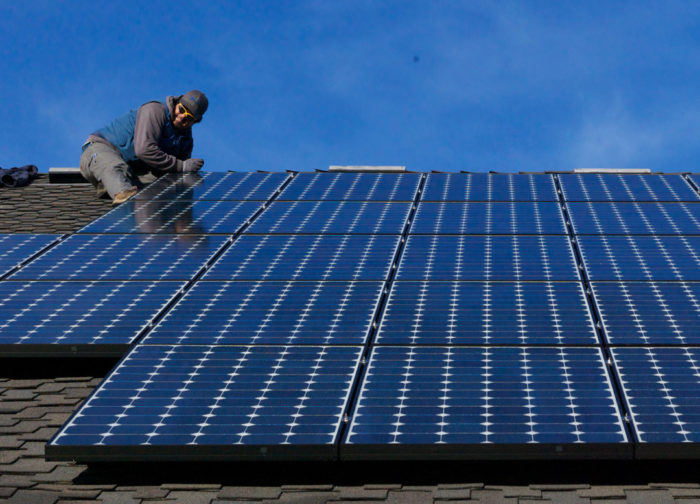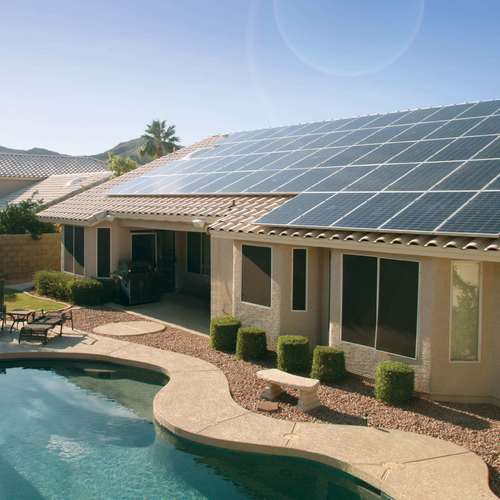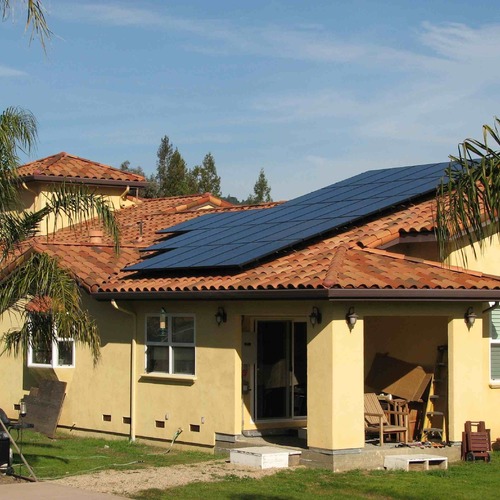
Image Credit: John Callas
An Arizona public utility has voted to impose new charges on customers who generate some of their own electricity with photovoltaic (PV) systems, arguing the extra income will help pay for grid infrastructure and maintenance, ThinkProgress reports.
Directors of the Salt River Project (SRP) voted in favor of the new fee late last month despite the appearance of some 500 protesters at their meeting in Tempe.
Chief Financial Executive Aidan McSheffrey said that the utility has no choice but to modernize the grid and improve reliability. But in a letter to SRP, SolarCity CEO Lyndon Rive promised to sue the utility for violating state and federal antitrust laws.
ThinkProgress said the additional “demand charge” would be based on a solar customer’s peak power demand during the month and would be imposed no matter how much power the customer provided to the grid.
Solar advocates get some concessions
The utility had originally proposed that the 15,000 existing solar customers in the state keep their current rates for 10 years before being switched to the new plan. But in the end, directors agreed to push that out to 20 years in response to customers who had calculated savings on their investments with a longer time line.
SRP also decided to allow customers who signed solar contracts before December 8, 2014 to keep the current rate plan for 20 years, ThinkProgress reports.
Finally, the utility said that it would use a 30-minute period of peak power demand rather than 15 minutes to determine the new demand charge.
Still, it’s not enough to deter SolarCity, which had urged SRP a week before the vote to withdraw the plan.
Rive wrote the new fee is “an unabashed penalty on customers who want to go solar and a deliberate effort to stop new solar installations.”
ThinkProgress adds that solar customers in neighboring New Mexico are looking at a similar proposal. There, the state’s largest electric utility proposed late last year a $30 monthly fee for solar customers in order to connect to the grid.
Weekly Newsletter
Get building science and energy efficiency advice, plus special offers, in your inbox.















11 Comments
Demand charges make sense, but only in the right context.
Demand charges would make sense if they were compensating the PV owner on a "value of solar" basis that includes the avoided grid infrastructure capital costs rather than the simple net-metering.
The notion that simple net-metering without demand charges is a cross subsidy of non-PV rate payers to PV owners in Arizona at current penetration levels is dubious at best, but the notion that it might become a cross subsidy by 2030 isn't far-fetched given recent years' growth rates. A demand charge approach to paying for the grid isn't terrible, but it's extremely premature to be taking that road at this time.
It's probably just a tax to
It's probably just a tax to cover for lost revenue due to solar customers producing their own power. $50 is excessive.
Stockholm syndrome
There will be those who, having been at the mercy of the anonymous utilities all their lives identify with the "thing" where the lights come from. Others do not feel all that beholding to the giant. In this case, it seems to me, the giant has stepped into a snare. Of all places not to harass people who have and will have Pv on their roof, Arizona is number One. With some of the best year round solar resources on planet earth, a $50 gratuitous charge plays into the grid exodus. And with smart types like solar city to stoke the flames it is just self destructive to launch this charge. But I welcome it, since we need models of what will happen to utilities in the next 5 years who are careless!
If you add 50 dollars a month
If you add 50 dollars a month added to the usual average of at least 10 dollar miscellaneous surcharges that adds up to 60 dollars a month - $720/year - $5040 for seven years - which is the average battery life. So it seems like a no brainer to go off grid with this kind of incentive. The only question then is if the grid defection will cause the utility to rethink its policy before the seven years is up. It's sort of like when one is in traffic and you see that your lane is slowing down and people are moving into the adjacent lane. By the time one notices it more often than not that lane is slowing down and the one you just moved from is the fast lane. The resultant fast that one just moved from is caused by the utility rethinking its policy because of the mass migration to off grid.
Reply to Eric
The cost of batteries is exactly what came to mind for me. $60 month is quite sufficent for battery back up. The other main issue in going off grid is simply "how clean is Arizona's grid?" So some people with green concerns might go off grid simply because the utilities don't listen to environmental concerns and we simply do not, anymore, have to wait for them to do the right thing.
Now, the next great theme I would like to see fully explored on GBA is "The New Off-grid House". There are traditional ways of living off grid (I have lived off grid for the last 15 years) but all the formulas have to be re thought now. The economics of PV have changed everything...and battery prices are going to plummet, what about thermal storage,what about ice batteries, what about hydrogen, what about clean generators vs utility coal....on and on. This topic is HUGE.
Potentially Good Timing
The utility could have just solidified a market for the upcoming Tesla Home Battery -- especially if it comes to market significantly cheaper then traditional SLA batteries. . . .
What about the very small user?
I can envision a small non-PV utility customer who uses less energy than a larger customer with a small PV system. In this scenario, shouldn't the small customer also pay a grid maintenance fee? This is a matter for the regulators -- to fairly allocate the cost of grid maintenance over the entire customer base, regardless of which way the energy flows, although likely dependent on peak energy demand. This situation is reminiscent of the Rural Electrification Act -- its origins and effects. Instead of solar panels, though, many rural farmers used windmills to generate their own electricity. The REA enabled the utilities to provide "real" electricity to those rural customers at fair rates.
Fees and Fairness
It seems to me that the arguments revolves around fairness.
I think the solution is that any utility that wishes to impose a fee makes that fee equally applicable to everyone. It is assumed that my electrical cost per kwh (about 10 cents where I live) includes the grid maintenance costs. If the utility were to split the grid maintenance and capacity costs out from the production cost, then everyone could be charged the same flat maintenance and capacity fee to be connected, and then a separate line item would be the cost of their consumption which would be tied to production costs only. Then maybe my bill would be less per kwh, but have the same grid maintenance fee as my neighbor.
Further, then the utility could purchase excess generation from Mr.PV at the same cost as their own generation, rather than the current practice of purchasing it at the peak demand rate (which is actually kind of unfair to the utility).
That, to me, seems like the fair way to do it.
Grtd attachment fees.
Here in New Brunswick, Canada, we pay a flat fee each month, regardless of consumption. It is slightly higher for rural areas. The fee is $20.38 for Urban connections. We pay 10.25 cents per Kw/hr.. Here is the conundrum: The less you use, the more you pay per unit of power. We also pay a 13% sales tax on the entire bill.
The average cost per Kw/hr is 11.7 cents, based on the average 24,000 Kw/hr usage of a bungalow, before tax. I use about 10,000 Kw/hr a year, so I end up paying 12.8 cents a Kw/hr before tax.
I don't think there is a really fair way of setting rates without good data. Does it cost less to maintain a connection to a house with minimal usage? Things like transformer service life. Perhaps based on peak demand? What about a lower rate for a certain amount of power, rising as usage rises? This might spur conservation
I guess it is not a simple answer.
Grid attachment fees
Roger, That sounds like what I had in mind.
I am not sure you can think of it as paying a higher per unit cost to use less (if I am understanding your statement correctly). You have to look at it as the attachment cost is X and the consumption cost is Y. If you use less Y, you pay less total. The X shouldn't be considered in your per unit cost calculation.
I think $20 for a fixed connection fee sounds reasonable, if it can in fact cover the maintenance and capacity cost for the utility. I got freaked out by the notion in the initial post of a $50 fee if you are connected to PV. I don't have PV and my total monthly bill, fees and all, is usually about $40, so why would I put in PV if it would make my bill HIGHER (I don't live in AZ, but I can only assume utilities will be looking to extrapolate this "precedent" in other markets)?
As you mention, it could get complicated if there is a sliding scale for a per/kwh rate depending on your total consumption, but utility companies don't seem to have any problem with making their billing structures complicated, so let's give it a try.
I also am not convinced that the power utility should pay us for our over-production. I'll size my system to meet my needs, and be glad I am grid tied when I can't meet them. People who want to be attached to the grid "for free" and also sell their excess PV production back to the utility seem to want to have their cake and eat it too (IMHO).
Lastly, I don't think a high connection fee would push many people to choose off grid. That takes a certain kind of commitment that most people don't want. Maybe a few would do that instead of paying the high fee if they are hardcore PV enthusiasts, but I think it is more likely that people would just opt not install PV if it will cost less them per month to simply draw fro the grid.
It gets complicated
when the company that owns the wires and substations doesn't own the generating equipment or even directly contract with them. My net-metered PV may provide a financial benefit overall to the system, but it may hurt Central Maine Power, whose source of revenue is fees associated with transmitting power produced by someone else. If I produce as much as I use, CMP doesn't get any money from me, except whatever the monthly grid fee is.
Log in or create an account to post a comment.
Sign up Log in